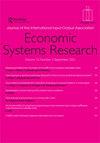Survey-based versus algorithm-based multi-regional input–output tables within the CGE framework – the case of Austria
IF 1.8
4区 经济学
Q2 ECONOMICS
引用次数: 4
Abstract
Spatial CGE models rely on detailed multiregional input–output (MRIO) tables. This paper compares two different approaches to compiling MRIO tables for Austria – an algorithm-based approach that regionalizes national input–output tables (IOT) and generates trade estimates using a predefined set of regional variables (i.e. Horridge’s algorithm), and a hybrid approach that uses as much regional and interregional data as possible. We investigate whether we observe differences in CGE simulation results that use them. Results from an aggregate simulation are surprisingly similar. So the algorithmic approach is, in fact, effective in making an MRIO from a national IOT. But noticeable differences appear at the sectoral level. They seem mainly due to differences in calibration rather than in regionalization.CGE框架内基于调查与基于算法的多区域投入产出表——以奥地利为例
空间CGE模型依赖于详细的多区域输入-输出(MRIO)表。本文比较了奥地利编制MRIO表的两种不同方法——一种是基于算法的方法,将国家投入产出表(IOT)区域化,并使用预定义的一组区域变量(即Horridge算法)生成贸易估计,另一种是混合方法,尽可能多地使用区域和区域间数据。我们调查是否在使用它们的CGE模拟结果中观察到差异。聚合模拟的结果惊人地相似。因此,算法方法实际上在从国家物联网中生成MRIO方面是有效的。但在部门层面出现了明显的差异。它们似乎主要是由于校准方面的差异,而不是区域化方面的差异。
本文章由计算机程序翻译,如有差异,请以英文原文为准。
求助全文
约1分钟内获得全文
求助全文
来源期刊

Economic Systems Research
ECONOMICS-
CiteScore
5.60
自引率
4.00%
发文量
17
期刊介绍:
Economic Systems Research is a double blind peer-reviewed scientific journal dedicated to the furtherance of theoretical and factual knowledge about economic systems, structures and processes, and their change through time and space, at the subnational, national and international level. The journal contains sensible, matter-of-fact tools and data for modelling, policy analysis, planning and decision making in large economic environments. It promotes understanding in economic thinking and between theoretical schools of East and West, North and South.
 求助内容:
求助内容: 应助结果提醒方式:
应助结果提醒方式:


